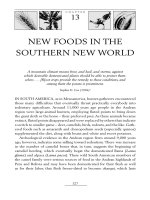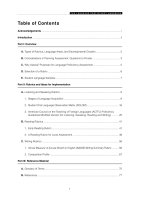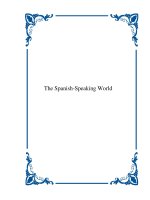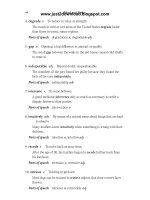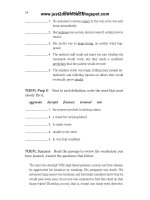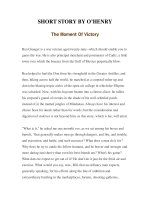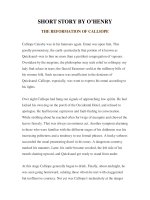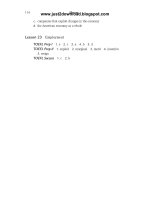THE LUNAR NEW YEAR doc
Bạn đang xem bản rút gọn của tài liệu. Xem và tải ngay bản đầy đủ của tài liệu tại đây (122.54 KB, 4 trang )
THE LUNAR NEW YEAR
Tet has become so familiar, so sacred to the Vietnamese that when Spring arrives,
the Vietnamese, wherever they may be, are all thrilled and excited with the advent of
Tet, and they feel an immense nostalgia, wishing to come back to their homeland for a
family reunion and a taste of the particular flavours of the Vietnamese festivities.
Those who have settled down abroad all turn their thoughts to their home country and
try to celebrate the festivities in the same traditional way as their family members and
relatives to relieve their nostalgia, never forgetting the fine custom handed down from
generation to generation.
And today, group 4 has a play to a few customs and practices are presented so that
we can better understand the traditional Tet of Vietnam, the Lunar New Year. Members:
…
_______________________
Tú is American, he comes to Vietnam to enjoys the traditonal festival, The Lunar New Year
(“Tết Nguyên Đán”). Hoa is studying at High School for the Gifted. She goes to meet Tú at the
airport.
Hoa: Tú! Tú!
Tú: Oh, hello. Thank you for picking me up.
Hoa: You're welcome. It's been a year but you haven't changed a bit.
How was your flight?
Tú: Great. I enjoyed it very much.
Hoa: Now, I’ll take you to Ben Thanh Market to buy many things for Tet.
Tú: Wow, It’s interesting! Let’s start!
At Tet, everyone, no matter how poor, tries hard to get enough money to make or buy some
banh chung or banh Tet, jams, fruits, flowers and new clothes for Tet. Vietnam is an age-old
agricultural country and therefore, most goods sold at Tet markets are agricultural products.
Since markets are closed for the three days of Tết , all necessary food items must be purchased
ahead of time. Therefore, in the days before Tết , the markets (especially the markets selling
traditional Tết flowers) are crowded with eager shoppers and sellers.
Hoa: First, we’ll buy some fruit for the “five-fruit tray”.
Tú: What kinds of fruits?
Trái cây: In northern areas, five-fruit trays ornamented with pomelos, peaches,
kumquats, bananas and persimmons are relatively smaller than those in southern areas
with coconuts, papayas, custard apples, mangos, and figs. As they sound like "cầu vừa đủ
xài" ( We pray for enough money to spend ) in the southern dialect of Vietnamese .
Tú: What does it mean?
Trái cây: The "five-fruit tray" on the ancestral altar during the Tet Holidays symbolizes
the admiration and gratitude of the Vietnamese to Heaven and Earth and their
ancestors, and demonstrates their aspiration for a life of plenty. This is one of the
general perceptions of life of the Vietnamese, which is “When taking fruit, you should
think of the grower”
Tú: How about watermelons? Are they considered lucky due to the red color?
Trái cây: That’s right! They hold much importance, people belief that watermelons with
scarlet and succulent would bring a wonderful year.
_________________________
Tú: What are these small red envelopes?
Lì xì: Giving money on the occasion of New Year or festivals is a popular custom in South
East Asian countries. This custom has also been much popular in Vietnam for generations
on the occasion of lunar new year which is named "lì xì" custom. On New Year festival,
the elderly normally give kids a small amount of money put in a very nice and small red
paper bag which symbolizes for luck, good fortune, named "tien mung tuoi" (money given
on the advancement in ages).
Hoa: Moreover, the red color of the envelope is supposed to ward off evil spirits.
Mứt: In Vietnamese New Year party, beside traditional dishes, no family can forget to
make a tray of “Mut Tet”, a cup of tea, betel and areca ready to entertain their visitors.
Tú: How can we made it?
Mứt: “Mut” is made from all sorts of fruit, including mandarin oranges, apples, banana,
coconuts, persimmons and breadfruit. “Mut” is made from all sorts of fruit, including
mandarin oranges, apples, banana, coconuts, persimmons and breadfruit.
_________________________
Hoa: Coming to Vietnam during the season of the Tet festival, the visitor is engulfed in
an ocean of colorful flowers.
Tú: Does Pink blossoms represent one of the distinct Vietnamese cultural
characteristics at Tet Festival. Where is it?
Bông: Oh. It’s called Peach blossom, which is traditional at Tet in the North while
apricot blossom is traditional in the South. The warm pink of the peach could very well
match the dry cold of the North, but the hot South seems to be flourishing in the riot
of the yellow of the apricot. Talking about ornamental plants for Tet, you cannot forget
peach blossom and apricot blossom , considered as traditional Tet's flowers. They bring
good luck to your houses in the new year, their colour is the symbol of happiness. Poor or
rich, the northern people cannot go without a twig of peach blossom in their homes, while
the southerners, a small branch of apricot blossom, together with a pot of Kumquat.
People say that if you have not had any one of them in your house, that means you have
not prepared for Tet.
Hoa: In addition, Neu is often planted on this occasion. It is a bamboo pole with green
leaves, an eight sign amulet and earthen bells hung from its top. Lime powder is
scattered round its base to allow the painting of cross-bows and arrows to chase away
the devils or keep them at bay.
Bông: Bows, arrows, bells and gongs are hung on the treetop with the hope that all the
bad luck of the past year will be chased away and everyone will have a happy New Year.
___________________________
When Tet is coming, everybody is so busy shoping, cleaning and decorating houses. Vietnamese
people cannot miss the Tet with p arallels, so interesting The red is symbolic of auspicious and
powerful vitality, according to popular belief. Mingling with the green of the Chung cake, the pink of
the peach blooms, the yellow of the apricot blooms, and the red of the parallels is sure to make the
Spring warmer and cosier. "Fat pork, salted onions, parallel sentences” written on red paper make a
meaningful Tet holiday for Vietnamese people
Hoa: On the occasion of Tet, parallels are written on red paper and hung in the place of
honor, usually on both sides of the entrance door or of the ancestral altar.
Ông đồ: Each pair of parallels has an equal number of words with contrasting or
corresponding meanings and lines of verses. They show a keen intelligence, perception of
nature and social life, uphold morality and a yearning for the well-being of all people. In
Vietnam in the old days, parallel sentences were composed during meetings between
literati, in salons, on the occasion of festival, weddings, and even funerals. According to
the circumstances, their contents might be solemn, laudatory, or mocking.
This is a famous pair of parallel sentences which sketches a colorful and clear
picture of the Tết holiday or Lunar New Year Celebration:
Thit mo, dua hanh, cau doi do
Cay neu, trang phao, banh trung xanh.
Fat meat, pickled onions, red parallel sentences Tet pole, sting of firecrackers, green
chung cakes
___________________
In the traditional conception of Vietnamese people, the process of making Chung cake is the
opportunity for family to come together. In the traditional conception of Vietnamese people, the
process of making Chung cake is the opportunity for family to come together. Nowadays, in some big
cities, the business lifestyle of modern society prevent people from preparing the cake, however, the
habit of worship ancestors with Chung cake never changes. It is the evidence of the Vietnamese loyalty
and deep gratitude to ancestors.
Tú: As I know, “Banh Chung” is the soul of Vietnamese New Year.
Hoa: It’s right. "Banh Chung" is a traditional and irreplaceable cake of Vietnamese
people in the Tet Holidays and King Hung's anniversary. For the Vietnamese, making
"Banh Chung" is the ideal way to express gratitude to their ancestors and homeland.
Chung cake was invented by the 18th Prince of Hung Emperor in the contest of
looking for new Emperor. According to the legend, 3,000-4,000 years ago, Prince Lang
Lieu, made round and square cakes, the round Day cake symbolizing the sky and the
square Chung cake symbolizing the Earth (under the ancient Vietnamese perception), to
be offered on the occasion of Spring.
Tú: What a significant legend! It reminds the next generations of the ancient
tradition as well as the primary of Chung cake. Besides, it emphasizes the important role
of rice and nature in water rice culture.
Main ingredients are glutinous rice, pork meat, and green beans wrapped in a square of
bamboo leaves that will give the rice a green color after boiling.
Hoa: Sticky rice must be very good and was soaked in water in the previous day. Rice
cake is wrapped in square shape, and the wrapping power must be neither tight nor loose.
Then the cake will be boiled in about 12 hours by wood. The Green Chung cake has
nutrition with an original tasty flavor and may be kept for a long time. Eating Chung cake
with vegetable pickles will bring you unforgettable taste!
Tú: What are other Food specialties for TET?
Hoa: Tết dishes can be found throughout the year and can be eaten at any time. the
preparation of food to offer to the ancestors is of special significance. Dishes to offer
to the ancestors differ in the Northern, Central and Southern parts of the country,
depending on their respective weather conditions at the time and on different local
agricultural products available. What is common in all regions of the country during Tet
holidays are the varieties of soups, fried, boiled, or stewed dishes, meat, fish,
vegetable there were always traditional dishes boiled chicken pork paste, spring rolls,
grilled chopped meat, brined meat, brined fish, pickled onion,
Tú: The foods that the Vietnamese eat at Tet are varied and diverse. What they have
in common is that the people throughout your country all want to have the best and the
most beautiful looking food on this occasion to offer their ancestors and to treat their
friends and guests.
_________________________
The Giao Thua is the most sacred point of time, the passage from the old to the new
year. It is popularly believed that in Heaven there are twelve Highnesses in charge of
monitoring and controlling the affairs on earth, each of them taking charge of one year.
The giao thua is the moment of seeing off the old chieftain upon the conclusion of his
term and welcoming in the new one upon his assumption of office. For this reason, every
home makes offerings in the open air to pray for a good new year.
After the giao thua is the start of the new year with many customs and practices,
amusements and entertainment, all of a distinct Vietnamese folk culture. you have an
opportunity to visit Vietnam during the Tet Holidays and to welcome the Tet Festivities,
together with the Vietnamese people, you will surely be profoundly impressed by the
distinct traditional culture that is rich in national identity.
People wait for every seconds the New Year coming. When the last seconds of old year
reach, all of them shouted "Happy New Year" and cheered at each other. Everyone was
so happy.
Fireworks have always been a big part of Tet celebrations. Firework shows will be
performed at locales. All shows will start simultaneously at 0:00 and last for 15 minutes.
On New Year’s Eve, after ritual offerings to ancestors, people put on new clothes and
head for the pagodas. Visiting pagodas to pray for a peaceful and prosperous year is a
tradition followed with fervor by Vietnamese devotees. major pagodas like Lang Ong Ba
Chieu, Vinh Nghiem, Xa Loi, Hoang Phap, are crowed with people.
The First Day is the most important day. All member must stay home. We call it family
day. Everybody sit down together, send wishes, give "lì xì", laugh, smiles, talk on
pleasures or visit other relatives. Young people send wishes of longevity to the old
people. One more age is counted to everybody when Tet comes.
Tet is an occasion for pilgrims and family reunions. It is an occasion when everyone sends
each other best wishes for a new year, stops thinking about unhappy things and says
good things about each other. We are all wish a happy, lucky and successful NEW YEAR!
Nhớ hox fần có dạ quang nhaz các bạn!
